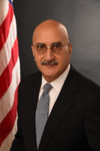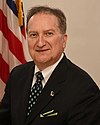
The United States Department of Health and Human Services (HHS) is a cabinet-level executive branch department of the U.S. federal government created to protect the health of the U.S. people and providing essential human services. Its motto is "Improving the health, safety, and well-being of America". Before the separate federal Department of Education was created in 1979, it was called the Department of Health, Education, and Welfare (HEW).
The Substance Abuse and Mental Health Services Administration is a branch of the U.S. Department of Health and Human Services. SAMHSA is charged with improving the quality and availability of treatment and rehabilitative services in order to reduce illness, death, disability, and the cost to society resulting from substance abuse and mental illnesses. The Administrator of SAMHSA reports directly to the Secretary of the U.S. Department of Health and Human Services. SAMHSA's headquarters building is located outside of Rockville, Maryland.

A medical guideline is a document with the aim of guiding decisions and criteria regarding diagnosis, management, and treatment in specific areas of healthcare. Such documents have been in use for thousands of years during the entire history of medicine. However, in contrast to previous approaches, which were often based on tradition or authority, modern medical guidelines are based on an examination of current evidence within the paradigm of evidence-based medicine. They usually include summarized consensus statements on best practice in healthcare. A healthcare provider is obliged to know the medical guidelines of their profession, and has to decide whether to follow the recommendations of a guideline for an individual treatment.

The Health Resources and Services Administration (HRSA) is an agency of the U.S. Department of Health and Human Services located in North Bethesda, Maryland. It is the primary federal agency for improving access to health care services for people who are uninsured, isolated or medically vulnerable.
The Office of Laboratory Animal Welfare (OLAW) oversees the care and use of research animals in any public or private organization, business, or agency. The Public Health Service consists of the National Institutes of Health (NIH), Centers for Disease Control and Prevention (CDC), the Food and Drug Administration (FDA), the Agency for Healthcare Research and Quality (AHRQ), the Indian Health Service (IHS), and the Substance Abuse and Mental Health Services Administration (SAMHSA). The agencies of the PHS are a part of the U.S. Department of Health and Human Services.
National Guideline Clearinghouse (NGC) is a database of evidence-based clinical practice guidelines and related documents. As of July 2, 2018, it will no longer be updated with new content, and it will no longer be available online as of July 18, 2018. As stated on its announcement page on June 18, 2018, federal funding is no longer available for it The entire content of the NGC is now available free of charge at The Alliance for the Implementation of Clinical Practice Guidelines. This site will begin uploading more current references in April 2020.
Patient safety is a discipline that emphasizes safety in health care through the prevention, reduction, reporting and analysis of error and other types of unnecessary harm that often lead to adverse patient events. The frequency and magnitude of avoidable adverse events, often known as patient safety incidents, experienced by patients was not well known until the 1990s, when multiple countries reported significant numbers of patients harmed and killed by medical errors. Recognizing that healthcare errors impact 1 in every 10 patients around the world, the World Health Organization (WHO) calls patient safety an endemic concern. Indeed, patient safety has emerged as a distinct healthcare discipline supported by an immature yet developing scientific framework. There is a significant transdisciplinary body of theoretical and research literature that informs the science of patient safety with mobile health apps being a growing area of research.
A Patient Safety Organization (PSO) is a group, institution, or association that improves medical care by reducing medical errors. Common functions of patient safety organizations are data collection, analysis, reporting, education, funding, and advocacy. A PSO differs from a Federally designed Patient Safety Organization (PSO), which provides health care providers in the U.S. privilege and confidentiality protections for efforts to improve patient safety and the quality of patient care delivery
Health services research (HSR) became a burgeoning field in North America in the 1960s, when scientific information and policy deliberation began to coalesce. Sometimes also referred to as health systems research or health policy and systems research (HPSR), HSR is a multidisciplinary scientific field that examines how people get access to health care practitioners and health care services, how much care costs, and what happens to patients as a result of this care. HSR utilizes all qualitative and quantitative methods across the board to ask questions of the healthcare system. It focuses on performance, quality, effectiveness and efficiency of health care services as they relate to health problems of individuals and populations, as well as health care systems and addresses wide-ranging topics of structure, processes, and organization of health care services; their use and people's access to services; efficiency and effectiveness of health care services; the quality of healthcare services and its relationship to health status, and; the uses of medical knowledge.

The German Agency for Quality in Medicine (AEZQ) - in German "Ärztliches Zentrum für Qualität in der Medizin (ÄZQ)", established in 1995 and located in Berlin, co-ordinates healthcare quality programmes with special focus on evidence-based medicine, medical guidelines, patient empowerment, patient safety programs, and quality management.

Günter Ollenschläger is a German physician, medical editor, and á former professor of internal medicine and clinical decision making at the University of Cologne, Faculty of Medicine.

A rural health clinic (RHC) is a clinic located in a rural, medically under-served area in the United States that has a separate reimbursement structure from the standard medical office under the Medicare and Medicaid programs. RHCs were established by the Rural Health Clinic Services Act of 1977, . The RHC program increases access to health care in rural areas by
- creating special reimbursement mechanisms that allow clinicians to practice in rural, under-served areas
- increasing utilization of physician assistants (PA) and nurse practitioners (NP)

ECRI is an independent nonprofit organization tasked with "improving the safety, quality, and cost-effectiveness of care across all healthcare settings worldwide."
The National Patient Safety Foundation (NPSF) was an independent not-for-profit organization created in 1997 to advance the safety of health care workers and patients, and disseminate strategies to prevent harm. In May 2017, the Institute for Healthcare Improvement (IHI) and NPSF began working together as one organization.
Collaborative Care is a healthcare philosophy and movement focussed on a systematised way of managing care and treatment for people with chronic conditions. Related ideas include: Integrated care, Primary Care Behavioral Health, Integrated care systems, and shared care. There are many studies establishing the long-term clinical and cost-effectiveness of collaborative care for people with physical–mental comorbidity. Nearly half of all people with a diagnosable mental health problem also have a long-term physical condition.
The Improvement Science Research Network (ISRN) is a research network for academics and physicians who are conducting studies in the new medical field of improvement science.

President George W. Bush signed the Newborn Screening Saves Lives Act of 2007 (Pub.L.110-204) (NBSSLA) into law on April 24, 2008, a day before DNA Day. The Act amended the Public Health Service Act to establish grant programs concerning newborn screening education and outreach, as parents are often unaware that newborn screening takes place and the number and types of screening varies across states. It also established grant programs to coordinate follow-up care, after newborn screening is conducted. The legislation also reauthorized programs under part A of title XI of the Public Health Service Act. In his introductory remarks, Senator Chris Dodd stated that the legislation "protect[s] the most vulnerable members of our society: newborn infants." Newborn Screening is a proven life saving and effective public health tool used to identify thousands of babies in the U.S. born with genetic, metabolic, and congenital conditions. At the time of the legislation's passage, only 15 States along with the District of Columbia required newborns to be screened for 29 core conditions as recommended by the Health Resources and Services Administration/American College of Medical Genetics' 2004 Report.
Health care quality is a level of value provided by any health care resource, as determined by some measurement. As with quality in other fields, it is an assessment of whether something is good enough and whether it is suitable for its purpose. The goal of health care is to provide medical resources of high quality to all who need them; that is, to ensure good quality of life, cure illnesses when possible, to extend life expectancy, and so on. Researchers use a variety of quality measures to attempt to determine health care quality, including counts of a therapy's reduction or lessening of diseases identified by medical diagnosis, a decrease in the number of risk factors which people have following preventive care, or a survey of health indicators in a population who are accessing certain kinds of care.
The Comparative Effectiveness Research Translation Network (CERTAIN) is a learning healthcare system in Washington State focused on patient-centered outcomes research (PCOR) and comparative effectiveness research (CER), leveraging existing healthcare data for research and healthcare improvement, incorporating patient and other healthcare stakeholder voices into research, and facilitating dissemination and implementation of research evidence into clinical practice.
Kathryn McDonald is an American scientist who is Bloomberg Distinguished Professor at the Johns Hopkins University. She serves as co-director of the Johns Hopkins Center for Diagnostic Excellence. McDonald previously led the Centre for Health Policy at Freeman Spogli Institute for International Studies. Her research considers what makes for high-quality and safe healthcare delivery systems.













